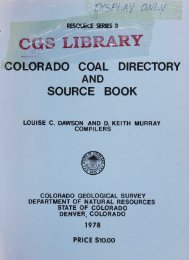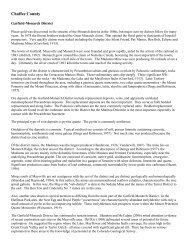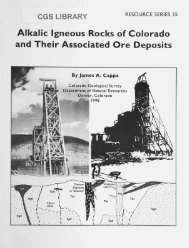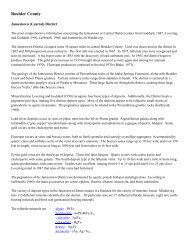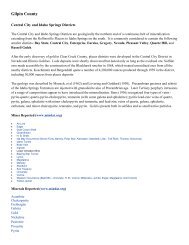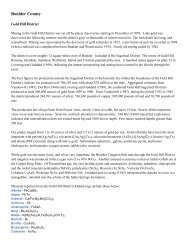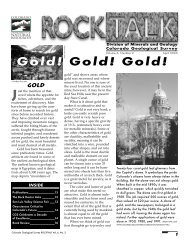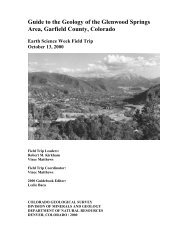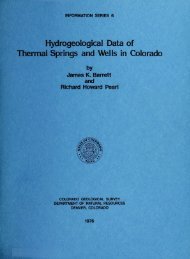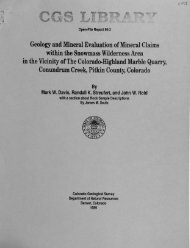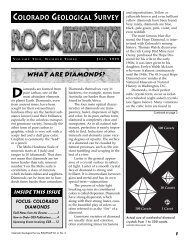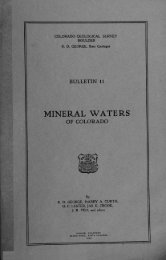Colorado Geological Survey
Colorado Geological Survey
Colorado Geological Survey
Create successful ePaper yourself
Turn your PDF publications into a flip-book with our unique Google optimized e-Paper software.
PHYSIOGRAPHY<br />
cally from the valley bottom; west of the river glacial boulders are found<br />
at practically all, elevations between the river land the cirques near the<br />
top of the Sawatch Range. Many glacial lakes are found between the valley<br />
and the crest of the range. Near Pando rocks show smoothing bymoving<br />
ice, and roches moutonnees are very common in Homestake Gulch.<br />
Two large glaciers have moved through the region, and converged or<br />
followed nearly the same path at and from a point about two miles northwest<br />
of Pando. One started near Fremont Pass in the Tenmile district,<br />
moved westward north of Chalk Mountain, and down the valley of Eagle<br />
River. There is good evidence that the greater part of the ice moved<br />
northwestward through the valley now followed by the highway north of<br />
Pando (Fig. 5), and not through the present valley of Eagle River where<br />
it bends to the right between Coal and Silver creeks. However, nearly<br />
Figure 5. Glaciated valley connecting Eagle and Homestake valleys, looking<br />
northwest; shows also dip slope of Sawatch quartzite in background<br />
all the hill between Eagle River and Homestake Creek nas been glaciated,<br />
and considerable morainal material is found close to Eagle River south of<br />
Red Cliff. A larger glacier headed high on the slopes of the S'awatch<br />
Range, moved down through Homestake Gulch, and scoured out the gulch<br />
to a depth of about 1,000 feet and to a width of a quarter of a mile. Midway<br />
between Pando and Red Cliff it joined the Eagle glacier, or followed<br />
the path of the Eagle glacier from this point northward. Other glaciers<br />
came into Eagle Valley north of the Homestake glacier. Both the Homestake<br />
and Eagle glaciers eroded their valleys to a depth considerably below<br />
the pre-glacial level. This is shown by the many hanging valleys, of which<br />
one is Yoder Gulch Where the creek forms a waterfall near the railroad<br />
(Fig. 6). Eagle Canyon between Homestake Creek and Rock Creek<br />
has evidently been much deepened by stream erosion since the glaciers<br />
melted. (See also interpretation by M. R. Campbell in Bulletin 707, U. S.<br />
<strong>Geological</strong> <strong>Survey</strong>, p. 115.) i<br />
17



